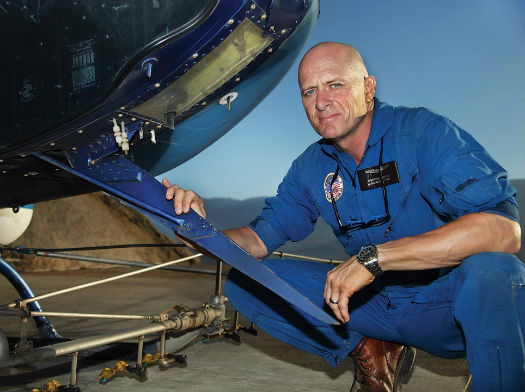
Colquhoun gets up close and personal with one of the fleet’s wire strike systems, installed only days before he flew through power lines. Without it, he believes the incident would have been fatal.
Doug Thiel, a good friend and veteran agricultural pilot, was a comforting voice on the end of the phone. “You’re ok, Jay. Now go and hug your wife and son extra close this night.” I’ll never forget the words, and I followed his advice. I had just flown through two high-voltage power lines and survived.
I remember the events of that day as clearly as if the moment has just passed. I’ve relived it often enough in nightmares. The very thought of it will jolt me awake, gasping for air and drenched in a cold sweat.
Flying into wires is often a fatal error, and although I feel lucky, I honestly think there was more to my escape than luck alone. Great training — and great instructors — lead to good judgment and good instincts. I was fortunate during my early training to be instructed by Mike Susi, who was a highly experienced pilot with Westchester County Police in New York. “No matter what happens, fly the goddamned aircraft,” he drilled in to me. All these years later, I honestly think that is what made the difference that day.

Flying in close proximity to power lines is a daily affair for agricultural (ag) and utility pilots. “Ag pilots are often at the mercy of where farmers have to plant their crops, and wires are an ever present challenge in today’s changing rural landscape,” said Colquhoun. Dan Megna Photo
The day of the accident
January 17 began much as any other day. My schedule called for an early pre-flight and departure for a day of low-level agriculture spraying (under Federal Aviation Regulations part 137 operations) in a Bell 206 JetRanger. The crop of the day was citrus, and the target was a nasty little bug that’s threatening to decimate that industry.
Upon arriving at the jobsite, the first load was followed by a main rotor transmission chip light. Upon inspection, a decision was made to take the aircraft out of service, and I jumped in another 206 that happened to be fresh out of a major airframe inspection. Its paint was fresh and vibrant, and it also had a newly installed Magellan Aerospace wire strike kit. The kit had been originally planned for installation several weeks later, but company owner Bob Hoag and I had decided at the last minute to schedule it ahead of the paint so that no touch-ups would be required. How could we have known how important that decision would be?
In agricultural (ag) flying, a wire strike system is a required piece of hardware, and to fly without one is courting disaster. I’m sure every ag or utility rotorcraft pilot has heard the expression about there being two kinds of helicopter pilots: those who’ve hit wires, and those who are going to. Cliché, right? Not for me.
It was a pleasure to fly that morning, in an aircraft in which I’d logged many hours. The air was cool and refreshing, with lots to bite into, and hundreds of acres of beautiful citrus trees awaited me. Load after load passed. I was in a wonderful groove with the aircraft and my ground crew, working the rows of trees, keeping myself hydrated and well fed, and even though I’ve thought about it hundreds of times, I know I was feeling fresh right to the very last load — that fateful load.
In ag flying, we are at the mercy of where the farmers decide to plant, and it’s not always ideal — there may be obstacles, houses and power lines littered throughout the site. But you deal with it — it’s your job — and when it comes to wires, you work within the confines of good judgment and safe margin. Through training and experience, you learn to understand patterns in wires, do recons of the fields, and fly with techniques that lead to safer applications. And if it means an area doesn’t get treated, farmers generally understand.
As the day was drawing to a close, I had covered a little over 500 acres, and decided that we would finish up in a few more loads. I began working a section of grapefruit that, like many others, had a large number of wires around it in multiple directions. I first surveyed the danger, then began systematically applying the load. The sun was low in the January afternoon sky as I laid a swathe next to a large set of wires on each side. Turning to the right, I dipped slightly and accelerated to a 45 mph application speed for the next pass, and the sky in front of me looked clear. It wasn’t.
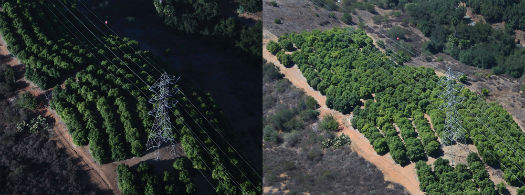
These photos show the same grove in contrasting light of early morning sun (left) and then mid-morning (right). Flying in and out of shadows can be dangerous, as it forces a pilot’s eyes to adjust too quickly. They can also hide other dangers during the visual transition.
Emergency Response
I didn’t see the wires, perhaps hidden in the swath of late afternoon shadows going across the grove, but they hit just below the pitot tube and made a thud like an oar on the side of a canoe. I actually said the words aloud, and I remember hearing them through my intercom — a faint “Oh no.”
When you are facing what appears to be your final moment, your life doesn’t flash before your eyes. At least not for me. I saw regret, thinking for a brief moment of all the things I’d leave behind: my wife, my son, and our life together.
The moment passed in an instant, and then the words of my old instructor, Mike Susi, hit me like a high-speed train. “No matter what happens, fly the goddamned aircraft!”
The wires had travelled into the lower wire-cutter, and I felt them tugging at the aircraft — such a foreign sensation in midair. The helicopter went into a serious nose-down attitude, and I felt it starting to go over. I was doing 45 mph with a full load at almost 3,200 pounds gross weight, and the wires were trying with all their might to stop me. “Fly the goddamned aircraft!”
What happened next was what I can only assume was learned instinct. I dumped the collective and pulled back into a flare to bring the nose up, but the tugging continued as the ship drew level and lost some speed.
Then it happened — the massive explosion of the electric arc as that beautiful wire cutter severed the wires. It was deafening, even under my helmet and over the sound of the rotor system, and I saw an enormous blue flash through my chin bubble. I looked in horror as one severed line, its end alight with blue flame, trailed across my door and right tank, heading towards my tail. The second severed wire snagged on my right spray boom and the ship started a hard right yaw; I pulled pitch, kicked some left pedal and pushed the nose forward. Suddenly, the aircraft broke free, and I prepared to crash into the trees as I flared one last time, not knowing if the tail was intact. Pedal input was positive — I was still in one piece — and as I came to a hover, I turned 360 degrees to be sure I was free of wires and no fires had started, before landing in a small clearing just next to the grove.
After shutting down, I grabbed the extinguisher and climbed out. The air outside was filled with the acrid smell of burnt electrics, and the site was a mess. The severed wires lay on the ground, and I noticed I had also pulled down two wooden utility poles.
I turned around and surveyed the damage to the aircraft. Pockets of soot surrounding charred paint were dotted across the chin bubble and underside of the helicopter, and there was a nasty burn on the right tank and door. Again, a twist of fate — I usually fly with the right door off, and the wire would have certainly hit me. The right boom was bent and burned a little, but it was superficial damage. The tail, blades and the rest of the aircraft were fine at first inspection.
My hands, trembling uncontrollably, reached for my cell phone. A call to the grove manager set things in motion. The power company was called, and the grove staff ensured nobody entered the area. I called Bob, my boss, and let him know what had happened — he was just relieved that I was ok.
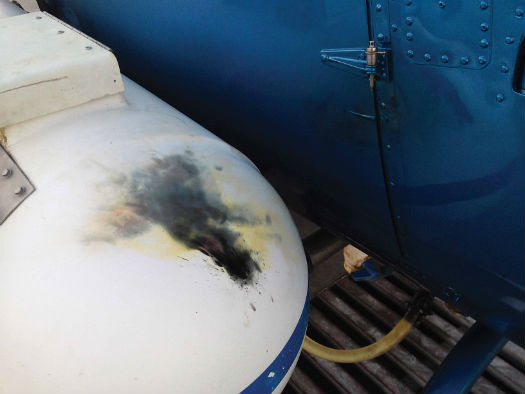

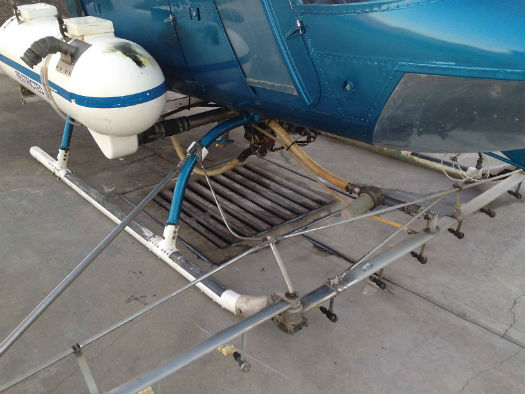
From top to bottom, helicopter damage from the wire strike ranged from burns and charred paint, to bent spray booms. Colquhoun is thankful to be alive.
Post-accident procedures
Bob and I talked, and the decision was made to contact our local Flight Standards District Office (FSDO) representative, and I left him a brief message of what had happened and how to contact me. Interestingly, a few people I spoke to immediately following the incident had told me that because I hadn’t crashed, it wasn’t actually necessary to speak to the Federal Aviation Administration (FAA). Well, they’re wrong. Any time an aircraft causes damage to power lines, the power company will automatically notify the FAA. So, when I received a call from my FAA FSDO rep the next morning, he told me that he was already aware of the situation by the time he had received my message.
Advice to all pilots: full disclosure is key in any accident or “incident.” Because of the way I had handled the situation, the FAA was very understanding and extremely helpful. The wire strike was listed as an “incident,” (as there was no aircraft damage or injury), and the power company handled the damage to the wires quickly and efficiently. The aircraft went through an intense inspection and was eventually returned to service.
Reflecting on the accident, I of course ask myself (almost daily) what I could have done differently. Ultimately, in ag flying, we work in an environment that is filled with potential hazards, and it comes down to good judgment to mitigate the risks presented by that environment. Perhaps I should have finished my day earlier, because the fact is I hit those wires, and it was pilot error. I should have seen them. I will still tell you I felt fine — but was I? I should have seen the wire.
Since this experience, I try to work the most difficult fields earlier in the day, although in this case it would have been a bit of a moot point, as there weren’t really any fields that were more or less difficult than any others. I also treat high contrast and confined areas with even greater care, opting to wait for overhead sunlight to better light them, as opposed to going in and out of shadowed areas early and late in the day.

One of Hummingbird’s early helicopters before all its aircraft had wire strike kits installed. Said Colquhoun, “Flying ag or utility without a wire strike system is courting disaster.” Dan Megna Photo
I try to identify future hazards that may be caused by low and late afternoon sun, as a lot can hide in the shadows, and I study patterns of wires, as there is usually a logical order to the way they are strung. Remember, it’s not just the power lines you need to be aware of, but also the support “guy” wires as well. These are often quite small and hard to see, and usually run on a 45-degree angle from the middle of the pole to an anchor point on the ground. Look at the big picture from a higher altitude, not directly down, but at an angle — and then do a low recon. The devil is in the details, and many wires won’t be visible from even 200 feet. Look at a site from a curious viewpoint: Could that little shack have power running to it?
Whenever possible, cross at the pole. Generally, there are not wires above that, and although wires should be avoided whenever possible, if you must fly near them, go more directly over them at higher altitudes. This gives you two options (left or right) for autorotation, instead of only one.
If you are working near wires, look at the wire, but the key in judging your distance from them comes from using peripheral vision and looking at the poles. Wires can play tricks on your eyes if you look directly at them, and they may appear further away or closer than they really are. But if you look at the pole, it can be a great guide.
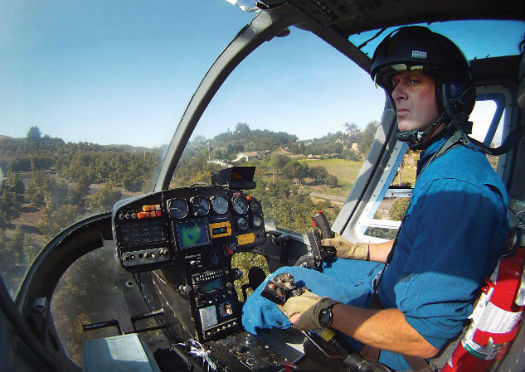
Although he’s sprayed many of the same groves and fields dozens of times, Colquhoun is always aware they could have new hazards. “With the ever increasing needs for electricity in today’s world, new power and phone lines are popping up all the time,” he said. Dan Megna Photo
Finally, never assume that “the wires weren’t there last time, so you’re good to go this time.” This mentality will get you killed. If you are operating outside of part 137, going under a set of wires (for example in limited visibility conditions) is forbidden. To those ag pilots who are required to do so during an application, remember that wires will droop slightly once the air temperature rises, and that the set of wires you flew under while treating that row of corn at 6 a.m. might be impassable at 10 a.m. Never assume it’s clear, and if you are nervous about an area, find another way in or out — and if you can’t, don’t.
As far as my outlook on the whole experience goes, the nightmares have subsided, but they are a frequent reminder. This kind of experience changes you, and revisiting it has been difficult for me, but also somewhat therapeutic. I try not to take life’s little gems for granted these days. Each new day is a gift, and if you get up early enough, it doesn’t belong to anyone yet.
Jason Colquhoun worked in photography in New York for seven years before becoming an ag helicopter pilot. He now resides with his wife, Lorie, and son, Grant, in peaceful Southern California.





